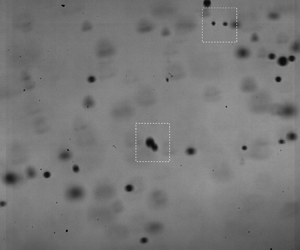Article contents
Experimental study of the effects of droplet number density on turbulence-driven polydisperse droplet size growth
Published online by Cambridge University Press: 23 April 2021
Abstract

Interaction of polydisperse droplets in a turbulent air flow features prominently in a wide range of phenomena, such as warm rain initiation as an example. In the current study, we present an experimental investigation on the effects of initial droplet field characteristics on the maximum droplet size growth. By performing experiments in a vertically oriented air flow facility, the air flow turbulence was able to be controlled through the mean flow velocity and an active turbulence generator. The initial droplet field characteristics (droplet diameter range of 0–120  $\mathrm {\mu }$m) were varied using spray nozzles of different flow numbers. Based on quantitative measurements of the droplet size distribution at various spatial locations using phase Doppler interferometry (PDI), we estimated the droplet size growth rate
$\mathrm {\mu }$m) were varied using spray nozzles of different flow numbers. Based on quantitative measurements of the droplet size distribution at various spatial locations using phase Doppler interferometry (PDI), we estimated the droplet size growth rate  $R$ as a function of turbulence intensity
$R$ as a function of turbulence intensity  $I$, initial droplet number density
$I$, initial droplet number density  $\rho _N$ and initial mean droplet size
$\rho _N$ and initial mean droplet size  $\bar {D}$. For each (
$\bar {D}$. For each ( $\rho _N$,
$\rho _N$,  $\bar {D}$), we observed the occurrence of an optimum turbulence intensity
$\bar {D}$), we observed the occurrence of an optimum turbulence intensity  $I^*$, with the corresponding maximum droplet size growth rate being
$I^*$, with the corresponding maximum droplet size growth rate being  $R^*$. Two different trends were observed. When
$R^*$. Two different trends were observed. When  $\rho _N$ and
$\rho _N$ and  $\bar {D}$ were simultaneously increased and decreased, respectively, their competing influences resulted in small variations in
$\bar {D}$ were simultaneously increased and decreased, respectively, their competing influences resulted in small variations in  $R^*$. In contrast, when
$R^*$. In contrast, when  $\bar {D}$ was held constant with a corresponding Stokes number
$\bar {D}$ was held constant with a corresponding Stokes number  $St$ smaller than unity, there existed a threshold
$St$ smaller than unity, there existed a threshold  $\rho _N$ above which
$\rho _N$ above which  $R^*$ increased rapidly with
$R^*$ increased rapidly with  $\rho _N$. These trends were then understood through long-distance microscopy (LDM) measurements. Beyond the aforementioned threshold
$\rho _N$. These trends were then understood through long-distance microscopy (LDM) measurements. Beyond the aforementioned threshold  $\rho _N$, the fraction of uncorrelated small-sized
$\rho _N$, the fraction of uncorrelated small-sized  $(St<1)$ droplet pairs was found to rapidly increase with
$(St<1)$ droplet pairs was found to rapidly increase with  $\rho _N$. Further detailed analysis of droplet tracking in the LDM images identified that the velocity fluctuations in the small-sized droplet pairs being induced by close encounters with inertial droplets was the underlying mechanism for the rapid increase of
$\rho _N$. Further detailed analysis of droplet tracking in the LDM images identified that the velocity fluctuations in the small-sized droplet pairs being induced by close encounters with inertial droplets was the underlying mechanism for the rapid increase of  $R^*$ with
$R^*$ with  $\rho _N$. This mechanism potentially explains how droplet collisions can be enhanced in small droplets if the droplet field is sufficiently polydisperse.
$\rho _N$. This mechanism potentially explains how droplet collisions can be enhanced in small droplets if the droplet field is sufficiently polydisperse.
- Type
- JFM Papers
- Information
- Copyright
- © The Author(s), 2021. Published by Cambridge University Press
References
REFERENCES
- 6
- Cited by



